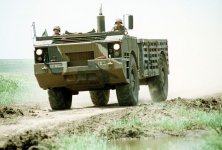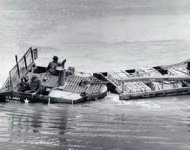You are using an out of date browser. It may not display this or other websites correctly.
You should upgrade or use an alternative browser.
You should upgrade or use an alternative browser.
Logistic Vehicle Modernization Project - Replacing everything from LUVW to SHLVW
- Thread starter McG
- Start date
daftandbarmy
Army.ca Dinosaur
- Reaction score
- 34,002
- Points
- 1,160
- Reaction score
- 8,516
- Points
- 1,160
What, on earth, are you lot moaning about?
The LSVW is a veritable paragon of military vehicles. A truck among trucks with hundreds of thousands of kilometers left on the clock
Sez here..... must be true.
http://news.nationalpost.com/news/own-your-own-army-convoy-highlights-from-the-canadian-governments-official-auction-site
The LSVW is a veritable paragon of military vehicles. A truck among trucks with hundreds of thousands of kilometers left on the clock
Sez here..... must be true.
In August and September of last year, the Department of National Defence suddenly sold off dozens of LSVWs (light support vehicle wheeled). These are insanely capable vehicles: Italian-designed, four wheel drive and with odometers all in the five digits. They were also remarkably cheap. During the army’s two-month-long light truck blowout, buyers picked these up for anything between $1000 and $5000 a unit. Which means that for the price of a brand new Ford F-150, the discerning consumer could have instead purchased a fearsome convoy of six one and a half ton army trucks. But be warned, these things are positively no frills; no radio, no airbags, no air conditioning, no ignition key.
http://news.nationalpost.com/news/own-your-own-army-convoy-highlights-from-the-canadian-governments-official-auction-site
Colin Parkinson
Army.ca Myth
- Reaction score
- 12,571
- Points
- 1,160
I bet that in civy hands they have sorted out the majority of the issues in a couple of months
- Reaction score
- 3,100
- Points
- 1,160
The Iveco that LS was ripper off, err based on, was quite a good vehicle. Only when it got Canadianized did it become an embarrassment. Same thing with the Iltis.
GK .Dundas
Army.ca Veteran
- Reaction score
- 1,693
- Points
- 960
While I'm not an automotive expert of any sort I suspect my Provincial Highway Department is or at least was.Colin P said:I bet that in civy hands they have sorted out the majority of the issues in a couple of months
Here in Manitoba a group of provincial mechanics got their hands on a LSVW for a couple of hours and examined it .To put it mildly they were not impressed .
The story goes that they produced a four page list of defects that had to be fixed before they would even think , think of allowing it on any road in the province. Assuming of course that it was a civilian vehicle .
Colin Parkinson
Army.ca Myth
- Reaction score
- 12,571
- Points
- 1,160
GK .Dundas said:While I'm not an automotive expert of any sort I suspect my Provincial Highway Department is or at least was.
Here in Manitoba a group of provincial mechanics got their hands on a LSVW for a couple of hours and examined it .To put it mildly they were not impressed .
The story goes that they produced a four page list of defects that had to be fixed before they would even think , think of allowing it on any road in the province. Assuming of course that it was a civilian vehicle .
having seen what they make people go through importing vehicles, most is chickenshit stuff or totally inappropriate to the vehicle in question.
QM
Jr. Member
- Reaction score
- 4
- Points
- 130
MilEME09 said:Anyone hear if the delivery schedule is on track for the MSVS SMP? first deliveries should be this summer.
First delivery will be December this year. There are challenges with transplanting the Renault production line and supply chain into Canada (Quebec and Saskatchewan), as one might expect. Much of that was based on problems with the numerous sub-contractors that feed said production line and supply chain. It seems its not easy to transplant an operation to the other side of the ocean. The armour and trailers will start trickling in through the fall, but delivery of the trucks themselves won't kick into high gear until 2018. In the meantime, it's AHSVS for the missions, and more of the same for Canada.
- Reaction score
- 35
- Points
- 560
Just as a bit of historical trivia, the US Army's heavy lift truck in the 1960's to early 1980's, the M 520, was not only fully articulated (which gave it some interesting cross country mobility) but also fully amphibious as well.
Funny how something like that was built using 1960 technology, but we can hardly get vehicles with limited cross country mobility today.
Funny how something like that was built using 1960 technology, but we can hardly get vehicles with limited cross country mobility today.
Attachments
MilEME09
Army.ca Veteran
- Reaction score
- 2,908
- Points
- 1,210
Thucydides said:Just as a bit of historical trivia, the US Army's heavy lift truck in the 1960's to early 1980's, the M 520, was not only fully articulated (which gave it some interesting cross country mobility) but also fully amphibious as well.
Funny how something like that was built using 1960 technology, but we can hardly get vehicles with limited cross country mobility today.
Armies fight wars, wars in places that aren't always paved, and have a gas station at regular distances, people seem to have forgotten that over many decades.
Colin Parkinson
Army.ca Myth
- Reaction score
- 12,571
- Points
- 1,160
Thucydides said:Just as a bit of historical trivia, the US Army's heavy lift truck in the 1960's to early 1980's, the M 520, was not only fully articulated (which gave it some interesting cross country mobility) but also fully amphibious as well.
Funny how something like that was built using 1960 technology, but we can hardly get vehicles with limited cross country mobility today.
Designed by people like this, not a computer in sight, but a lot of education and experiance.

- Reaction score
- 8,516
- Points
- 1,160
Colin P said:Designed by people like this, not a computer in sight, but a lot of education and experiance.
I miss the smell of a decent pipe. Contributory to a convivial working atmosphere.
QM
Jr. Member
- Reaction score
- 4
- Points
- 130
For relatively low tech equipment like trucks, Canada buys what industry produces. Our quantities are too small to make designing our own trucks and having someone build them, economically viable. Performance standards are examined and set, but the existing military trucks invariably meet them anyhow (fording depth, mobility, cargo capacity, crane lift capacity, protection, etc). We then cross check to see which of the upcoming lineups of existing military truck manufacturers, none of whom are Canadian, will meet our requirements. If enough manufacturers have lineups that meet our needs, thus allowing a competitive process, we're good. Since the manufacturers all sell to our NATO partners, who have virtually the same truck requirements as us, the lineups invariably meet Canadian requirements. Its then just a matter of who puts together the best bid package between MAN and Oshkosh and Mercedes and Navistar and Iveco and Mack / Renault, etc.
Colin Parkinson
Army.ca Myth
- Reaction score
- 12,571
- Points
- 1,160
We can't even write a decent scope of work or contract. Basically all we need to ask is weight class and in service within NATO or countries X,Y and & Z. Then go from there.
QM
Jr. Member
- Reaction score
- 4
- Points
- 130
Chris Pook said:You could also ask what performance tests they have already passed and service history with other countries (Mean Miles Between Failures).
Performance histories in other NATO partners are always requested and provided. Nothing is so straightforward though. The 2010 truck the Americans or Germans are using is not the same as the 2019 truck that Canada will buy, and there are hundreds of pages of other assessments required by PSPC and ISEDC (all on behalf of Treasury Board, sigh). And (worse) technical performance is only one component of the bid evaluation alongside price and industrial benefits. To boot, the bidding companies have their lawyers lined up to jump on any perceived discrepancy in the evaluations. Ain't nothing easy in government procurement.
- Reaction score
- 8,516
- Points
- 1,160
Log Offr said:Ain't nothing easy in government procurement.
Sympathies.
Similar threads
- Replies
- 2
- Views
- 10K
- Replies
- 2
- Views
- 12K
- Replies
- 943
- Views
- 746K




